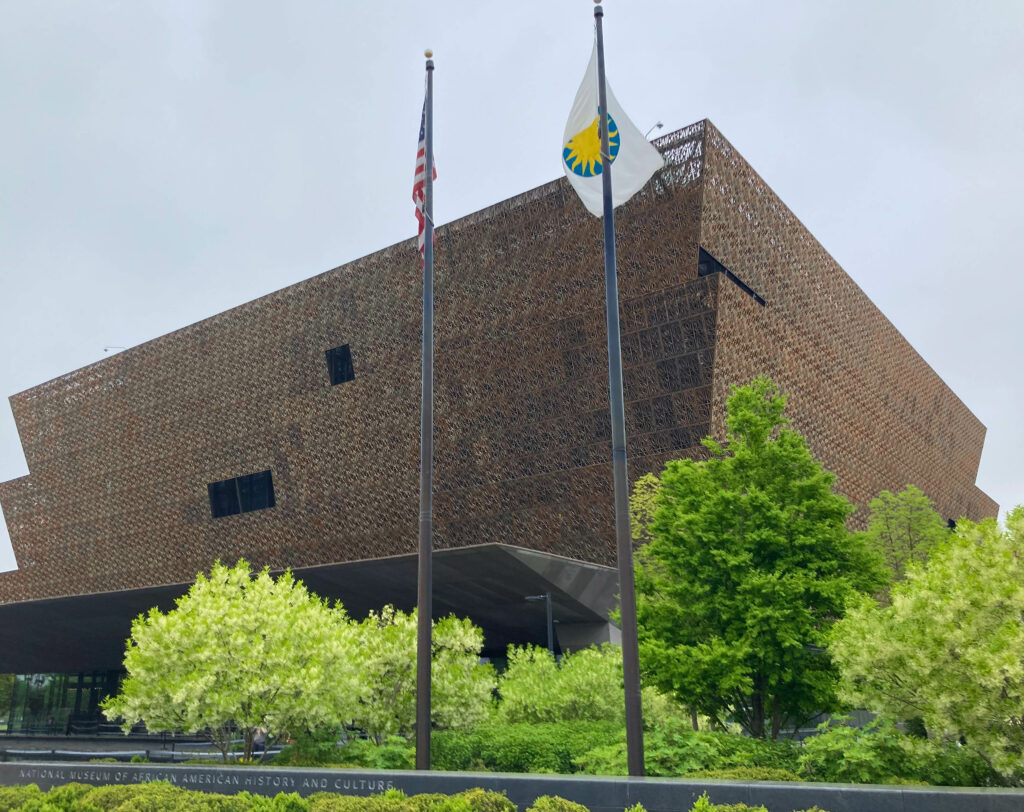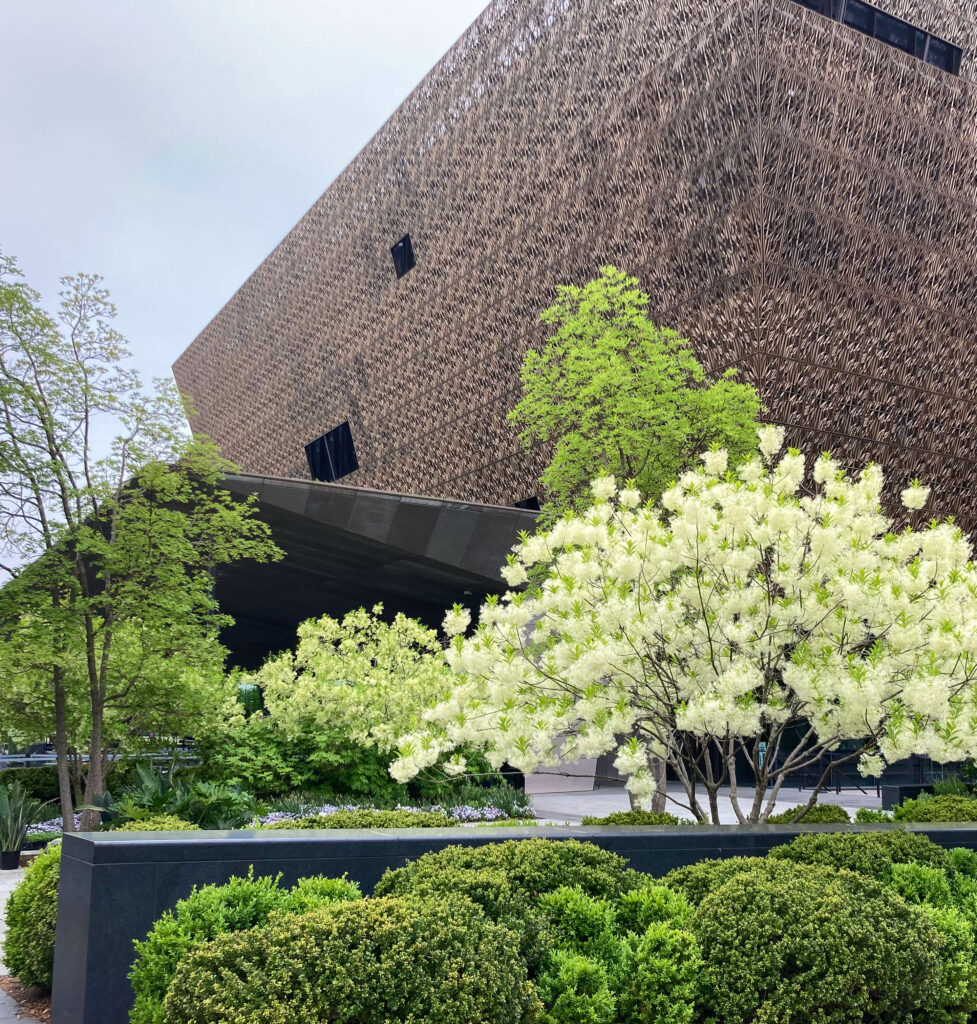- The Smithsonian‘s National Museum of African American History and Culture is located on the National Mall in Washington, D.C.
- The closest Metro stops are Smithsonian and Federal Triangle. Ride-share is also convenient in Washington; driving and parking are not.
- The Museum is free of charge to explore, but timed-entry passes are required.
The National Museum of African American History and Culture in Washington, D.C., displays more than 3,000 items that cover nearly every aspect of the black story in America, from slavery to celebrity.
You most likely won’t be able to take in all the exhibits during one visit. I’ve been twice, and I still could explore more. The purpose of this post is to give you a sample of the key things to see, especially if it’s your first visit or your time is limited.

Visitors enter the Museum at street level into Heritage Hall. From there you can decide whether to explore the below-ground History Galleries or the upper-level Community and Culture Galleries first. While both sections have their darker and lighter aspects, the History Galleries overall are more disturbing, while the Community and Culture Galleries are more uplifting. For this reason, I suggest starting with the History Galleries. To do so, you take an escalator one level down to the Concourse and then an elevator or stairs down to the lowest floor of the Museum.
This post contains affiliate links. For more information, click here.
C3: Slavery and Freedom
The History Galleries open where the black story in America horrifically began: with slavery. Displays explore the trans-Atlantic slave trade and the harshness of slavery in North America.
A section on the American Revolution teaches the role of black slaves and subjects in the birth of the United States. Crispus Attucks was killed at the Boston Massacre in 1770, arguably becoming the first person to die for American independence. Prince Whipple served during the storied crossing of the Delaware River and the crucial Battle of Trenton in 1776. James Armistead (Lafayette) was a spy who provided information that helped bring about the American victory in 1781 at Yorktown, the decisive battle of the Revolutionary War.
An exhibit called “The Paradox of Liberty” highlights the tensions of forming a new nation on the grounds of liberty and equality while keeping chattel slavery. A large statue of Thomas Jefferson stands in front of a stack of bricks, each labelled with the name of a slave. Displayed on the wall are words from his Declaration of Independence, including: “all men are created equal”.
The exhibit continues through the Civil War and Reconstruction. One of the most notable items is a slave cabin from South Carolina.
C2: The Era of Segregation
The next level teaches about life under Jim Crow laws. These petty codes enforced racial separation in everything from schools to drinking fountains, especially in the South. Visitors can walk through a Southern Railway passenger car with segregated compartments. Nearby is an interactive exhibit where you can sit at a recreation of the Woolworth’s lunch counter in Greensboro, North Carolina, and ponder whether you might join certain resistance efforts.
This part of the Museum also explores lynching. One of the most moving items on display is the original coffin of Emmett Till, the 14-year-old black boy brutally murdered in 1955. (This was the spot where I cried.)
C1: A Changing America
The final floor of the History Galleries brings the story into the 21st century. It highlights the assassination of Martin Luther King, Jr., in 1968 and concludes with the election of Barack Obama as President 40 years later in 2008.
Concourse: Contemplative Court
After exploring the History Galleries, you can return to the Concourse. Here is the Contemplative Court, a peaceful space with a waterfall and banquette seats. You can rest, reflect, and recharge before heading to the upper levels.
L2: Explore More
This space houses interactive displays. A stand-out exhibit highlights “The Negro Motorist Green Book“. The Green Book was essentially a travel guide for black Americans, especially in the segregated South. It was the brainchild of Victor Hugo Green, a Harlem mailman. Published during 1936-67, it provided information on hotels, restaurants, and other necessary stops that would welcome black travellers. The highlight of the exhibit is a simulated road trip through the South. The visitor sits behind a steering wheel and faces various dilemmas — where to eat, where to stop for gasoline, how to escape a racist cop when you have a flat tire. A version of this exhibit is currently travelling to museums in different cities around America.
L3: Community Galleries
The exhibits here focus on black contributions to the military and sports. My favorite item was the Dodgers jersey worn by Jackie Robinson, who served in a segregated Army during World War II before becoming the first black man to play in a 20th-century Major League Baseball game in 1947. A year later, President Harry S Truman desegregated the Armed Forces.
L4: Culture Galleries
The top floor covers the arts, particularly black music from jazz to hip-hop. An unmissable item is the red Cadillac El Dorado belonging to rock ‘n’ roll star Chuck Berry.
But my favorite spot on the floor was the windows looking out to the National Mall. It reminded me of the hopeful view of the hills of Jerusalem from the Holocaust museum Yad Vashem.
Like most museums that explore horrifying historical wrongs, the National Museum of African American History and Culture is also hard to visit, but it’s hopeful as well. It explores American history from the point of view of black slaves, subjects, and citizens. And it illuminates the triumph of the ideals of America’s founding over the flaws of America’s founders.
What to Know before You Go
to the National Museum of
African American History and Culture
The National Museum of African American History and Culture is located at 1400 Constitution Avenue in Washington, D.C. The nearest Metro stations are Federal Triangle and Smithsonian on the Blue, Orange, and Silver lines. It is also a short walk (10-15 minutes) from Metro Center on the Blue, Orange, Silver, and Red Lines. I usually ride-share; Uber and Lyft are quick and efficient in Washington. Driving and parking are difficult, and I do not recommend them.
Unfortunately, there is only one eating venue. The Sweet Home Café serves a limited menu of mediocre, over-priced lunch items and pre-packaged junk food. If you’re going to make a day of the Museum, I suggest eating a hearty, protein-based breakfast and planning on an early dinner.
Lockers are available on the entrance level. Wear comfortable clothes and walking shoes. Allow 4 to 6 hours.
As a Smithsonian venue, the Museum is free of charge to visit. But you must reserve a timed-entry pass online. You will also have to go through a security screening to enter. The Museum is often very crowded. You may face long lines to enter, go through security, and tour the exhibits. Fortunately, if the crowds become too crushing, there are lots of other sites within walking distance, including:
- National Museum of American History
- Washington Monument
- National Museum of Natural History
- United States Holocaust Memorial Museum
- White House Visitor Center
- National Museum of Asian Art
- National World War II Memorial
Excellent hotels within walking distance include:
Planning travel to Washington, D.C.? You might like:
After my misspent youth as a wage worker, I’m having so much more fun as a blogger, helping other discerning travellers plan fun and fascinating journeys. Read more …

